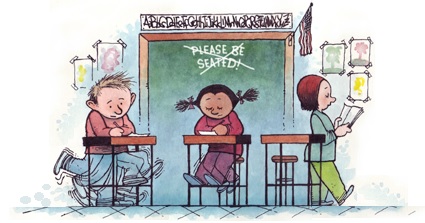Simple Tools to Help Students Focus
Aug 23rd 2018

With the start of school it can be a challenge for students to settle in and focus. Below are a few simple tools you can use to help improve focus and attention to task.
Provide students with a Fidget
Fidgets are small toys a student can hold in their hand that can help students increase focus and attention. (Rotz, Wright, 2005) Good fidgets should have a combination of an interesting tactile composition, pliability, and some movement opportunities for the hands and fingers. Note: fidgets should not draw attention to the fidget - we are not big fans of fidget spinners!
Provide Active Seating
Let students sit on a seating disc or stand while they work. Literature indicates positive effects of dynamic seating for children with attention-deficit hyperactivity disorder (ADHD) and pervasive developmental disorders (PDD) for attention and classroom behaviors (Schilling & Swartz, 2004; Schilling, Washington, Billingsley, & Deitz, 2003).
As a group, students with IEPs and those considered At-Risk demonstrated overall improvements and/or consistencies in rate, accuracy, fluency, and comprehension while seated on an air-filled cushion. Students with IEPs showed the greatest increase in reading rate and comprehension with a full or almost full grade level of improvement noted. Best of all, both the teacher and the students in this study noted that the air-filled cushion was not disruptive and easily fit into the classroom routine.
The Power of Deep Pressure
Use a Weighted Vest or Weighted Lap Pad. According to a study by the Challenge Infant Developmental Center, Brooklyn, New York (Fertel-Daly, Hinojosa, 2001) children with autism, who used a weighted vest, displayed an increase in attention to task and decrease in self-stimulatory behaviors. The most consistent improvement observed was the decreased number of distractions.
Use a Timer
Use a visual timer to help students focus. A visual timer can help students understand the passage of time and help them to monitor their own activities. Better time awareness can help with focus and attention and also relieve stress and anxiety.
Make a Wait Card
Help students focus by creating a simple card with the word wait written on it. For some students this extra reminder can help to keep them seated. It's important when using a wait card to make sure there is ample time for breaks.
Kick Away Energy
Help fidgety students focus and burn off some energy with an kick band. Place the band around the bottom of your students two front chair legs. Students can sit and fidget with their feet without disturbing the class.
Roland Rotz, Sarah Wright (2005) Fidget to Focus, New York, iUniverse, Inc.
Schilling, D. L. & Schwartz, I. S. (2004). Alternative Seating for Young Children with Autism Spectrum Disorder: Effects on Classroom Behavior. Journal of Autism and Developmental Disorders. 34, 423-432.
Schilling, D.L., Washington, K., Billingsley, F.F., Deitz, J. (2003). Classroom seating for children with attention deficit hyperactivity disorder: Therapy balls versus chairs. The American Journal of Occupational Therapy, 57(5), 534-41.
Fertel-Daly D, Bedell G, Hinojosa J., (2001). Effects of a weighted vest on attention to task and self-stimulatory behaviors in preschoolers with pervasive developmental disorders. The American Journal of Occupational Therapy, Nov-Dec;55(6):629-40.
